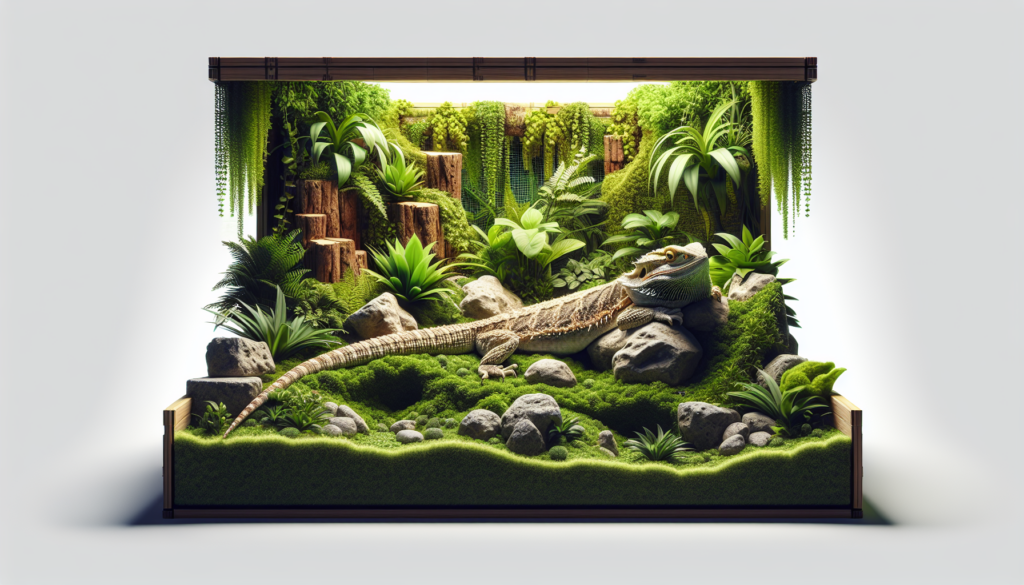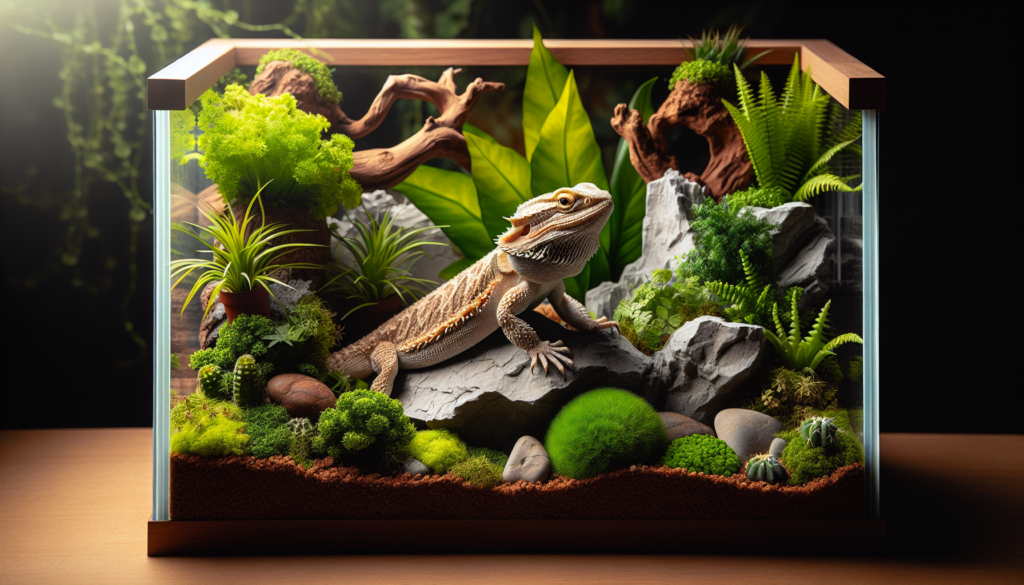Imagine creating a miniature oasis filled with lush green plants, warm rays of sunlight, and a cozy basking spot for your new bearded dragon companion. This is precisely what a bearded dragon terrarium offers – a perfect home for these fascinating reptiles to thrive and explore. In this article, we will guide you through the essentials of setting up a bearded dragon terrarium, ensuring that your scaly friend has a comfortable and vibrant habitat to call their own. So, grab your gardening gloves and let’s embark on this exciting adventure of creating a haven for your bearded dragon!
Setting up the Bearded Dragon Terrarium
Setting up a proper terrarium for your bearded dragon is essential to ensure their health and well-being. A well-designed terrarium will provide a comfortable and secure environment for your dragon to thrive in. To set up the perfect terrarium, there are several factors to consider, including the size of the terrarium, the ideal location, creating a secure enclosure, installing proper ventilation, temperature and humidity control, decorating the terrarium, providing essential lighting, selecting a comfortable substrate, choosing appropriate accessories, and maintaining a clean environment. Let’s dive into each of these aspects in detail:
Choosing the Right Size Terrarium
When it comes to selecting the right size terrarium for your bearded dragon, it is crucial to consider their specific needs. The size of the terrarium should provide adequate space for your dragon to move around comfortably and exhibit natural behaviors. A larger terrarium allows for a better living environment and encourages physical activity.
The size of the terrarium may vary depending on the age and size of your bearded dragon. For juvenile dragons, a 20-gallon terrarium is typically recommended. As they grow into adulthood, a 40-gallon terrarium or larger may be necessary to accommodate their increasing size. Larger enclosures allow for more freedom of movement and enable the dragon to display natural behaviors such as climbing and exploring.

Selecting the Ideal Location
Choosing the right location for your bearded dragon’s terrarium is essential for their overall well-being. Several factors should be taken into consideration when determining the ideal location.
It is crucial to evaluate the temperature and lighting requirements of the terrarium. Placing the terrarium in an area that receives direct sunlight or is exposed to drafts can negatively impact the environment inside the enclosure. Ensure that the terrarium is placed away from windows or doors that may cause temperature fluctuations or expose the dragon to direct sunlight.
Consider the household traffic and noise levels in the chosen location. High-traffic areas may cause stress to your bearded dragon, while excessive noise can disturb their sleep patterns and overall well-being. Choose a quieter area of your home where your dragon can feel safe and secure.
Finding a suitable placement for the terrarium is key. Consider areas where the terrarium can be easily accessed for maintenance and cleaning. Additionally, ensure that the terrarium is placed on a sturdy and level surface to prevent any accidents or instability.
Creating a Secure Enclosure
Creating a secure enclosure is vital to ensure the safety of your bearded dragon. There are several factors to consider when choosing the right enclosure type and designing a secure environment.
Select an enclosure that is appropriate for your dragon’s needs. Options include glass terrariums or custom-built enclosures. Evaluate the material, size, and design of the enclosure to ensure it meets the requirements for your dragon’s size and behavior.
To maintain a secure environment, it is crucial to prevent your bearded dragon from escaping. Check for any gaps or openings in the enclosure that could allow your dragon to squeeze through. Ensure that the lid or top of the enclosure is secure and cannot be easily opened.
If you have other pets in your home, it is crucial to prevent their access to the bearded dragon’s terrarium. Bearded dragons may be seen as prey by certain animals, so it is essential to create a barrier or keep the terrarium in a separate room where other pets cannot enter.

Installing Proper Ventilation
Proper ventilation is necessary to maintain a healthy and comfortable environment within the bearded dragon terrarium. Good ventilation helps to prevent the buildup of stale air, humidity, and odors that can be harmful to your dragon.
Ensure that the terrarium has proper ventilation options. This can include vents or mesh areas on the sides or top of the enclosure. The ventilation should be designed to allow for adequate air exchange without compromising the security of the enclosure.
Applying proper ventilation techniques is essential for the well-being of your bearded dragon. Avoid completely sealing the terrarium, as it can lead to poor air quality and excessive humidity. Regularly check the ventilation areas to ensure they are free from debris or blockages.
Temperature and Humidity Control
Maintaining the correct temperature and humidity levels within the bearded dragon terrarium is crucial for their overall health and well-being. Creating a temperature gradient, providing adequate heat sources, and regulating humidity levels are essential aspects to consider.
Bearded dragons require a temperature gradient within their terrarium to thermoregulate. This means providing a range of temperatures in different areas of the enclosure. Secure heat sources, such as heat lamps or ceramic heat emitters, at one end of the terrarium, creating a warmer basking spot. The opposite end should be cooler, allowing your dragon to cool down if needed.
Installing a thermometer and hygrometer within the terrarium is important to monitor and maintain the appropriate temperature and humidity levels. This allows you to adjust the heat sources or adjust the humidity levels as necessary.
Regulating humidity levels within the terrarium is vital. Bearded dragons require a specific range of humidity, typically between 30% and 40%. Providing a shallow water dish and misting the enclosure with water can help maintain adequate humidity levels.
Decorating the Terrarium
Creating a visually appealing and stimulating environment within the bearded dragon terrarium is not only aesthetically pleasing but also beneficial for their overall well-being. Choose safe and natural decorations, as well as structures that allow for hiding and climbing.
When choosing decorations, ensure they are safe for your dragon. Avoid using materials that may be harmful if ingested or have sharp edges that could cause injury. Natural items such as rocks, branches, and logs can serve as climbing structures and hiding spots for your dragon.
Creating a stimulating environment can be achieved by introducing various elements. Consider adding artificial backgrounds, plants, and other visual elements to make the terrarium more interesting. These additions can also provide additional climbing opportunities and environmental enrichment.
Providing the Essential Lighting
Proper lighting is essential for the health and well-being of your bearded dragon. Understanding the importance of lighting, using the right UVB lights for vitamin D synthesis, selecting the appropriate heat source, and creating a lighting schedule are key factors to consider.
Lighting plays a critical role in the synthesis of vitamin D3 in bearded dragons. UVB lights are necessary to provide the essential UVB rays that help metabolize calcium and prevent metabolic bone disease. It is important to choose high-quality UVB lights and replace them regularly according to manufacturer guidelines.
In addition to UVB lights, bearded dragons also require a heat source to maintain their body temperature. Heat lamps or ceramic heat emitters can be used to provide the necessary warmth within the terrarium. Ensure that the heat source is positioned in a way that allows your dragon to bask and absorb heat.
Creating a lighting schedule that mimics natural sunlight is beneficial for the bearded dragon’s overall well-being. Provide a regular cycle of light and dark periods to establish a natural day and night rhythm. This can be achieved by using timers to control the lighting within the terrarium.
Creating a Comfortable Substrate
Selecting a suitable substrate for the bearded dragon terrarium is important for their comfort and hygiene. Choose options that are safe and avoid materials that can cause harm or be ingested.
Several substrate options are suitable for bearded dragons, including reptile carpet, newspaper, and tile. These options provide a clean and easily maintainable surface for your dragon. Avoid loose substrates such as sand or wood chips, as they can be ingested and lead to digestive issues.
Hygiene and easy cleaning are key aspects to consider when choosing a substrate. Ensure that the chosen substrate can be easily cleaned and does not harbor bacteria or parasites. Regular cleaning and spot cleaning of the substrate are necessary to maintain a healthy environment.
Selecting the Appropriate Accessories
Choosing the right accessories for the bearded dragon terrarium is important to provide additional comfort and enrichment. Consider items such as food and water dishes, hides, and climbing structures.
Food and water dishes should be sturdy and easily accessible for your dragon. Choose dishes that are large enough for them to fit comfortably and clean them regularly to prevent bacterial growth.
Hides and climbing structures are essential for your bearded dragon’s mental and physical stimulation. Provide various sizes and shapes of hides to allow your dragon to retreat and feel secure. Introduce climbing structures such as branches or platforms to encourage natural behaviors and exercise.
Maintaining a Clean Environment
Maintaining a clean environment within the bearded dragon terrarium is essential for the health and well-being of your dragon. Establishing a regular cleaning routine, handling waste and removal, preventing and controlling odors, and sanitizing and disinfecting the terrarium are crucial steps to follow.
Establish a regular cleaning routine that includes daily spot cleaning and weekly deep cleaning of the terrarium. Remove any waste or uneaten food promptly to prevent the buildup of bacteria or parasites.
Regularly clean and disinfect the food and water dishes to maintain a hygienic environment. Use reptile-safe cleaning products or a diluted bleach solution to sanitize the terrarium periodically. Ensure all cleaning products are rinsed thoroughly before reintroducing your dragon.
To prevent and control odors within the terrarium, maintain a clean and well-ventilated environment. Regularly check and clean the ventilation areas to prevent the buildup of stale air. Proper temperature and humidity control can also help minimize odors.
In conclusion, setting up a bearded dragon terrarium requires careful consideration of various factors. By choosing the right size terrarium, selecting the ideal location, ensuring a secure enclosure, installing proper ventilation, controlling temperature and humidity, decorating with safe and stimulating elements, providing essential lighting and a comfortable substrate, selecting appropriate accessories, and maintaining a clean environment, you can create a perfect home for your bearded dragon. Remember to regularly assess and adjust the terrarium setup based on your dragon’s needs, ensuring their overall health and well-being.
